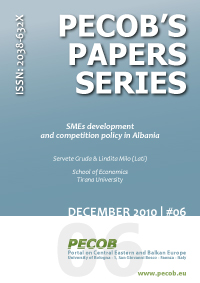and Balkan Europe
by IECOB & AIS Università di Bologna

This area collects and offers a wide range of scientific contributions and provides scholars, researchers and specialists with publishing opportunities for their research results
SMEs development and competition policy in Albania
December 2010 | #06
by: Servete M. Gruda & Lindita Milo (Lati)
pp: 26
ISSN: 2038-632X

- December 2010 | #06
Abstract (*)
Albania was the last country in South-eastern Europe to start implementing the principles of a free market economy after 1990. As a small country, its market is dominated from small and medium firms. In this respect, the development of Albanian small and medium firms is now an important issue for policy-maker and this process is broadly similar to that found in other transition economies. The aim of this paper is to present the main patterns of the small and medium enterprises and the impact on the level of the competition law and policy enforcement in Albania.
In the early transition, competition was an inherent phenomenon of the market, and actions related to it were new to Albanians. Competition went beyond the economic aspect: it affected the broader political and social life because the preceding system had excluded competitiveness from all aspects with the main role played by the State, thus completely eliminating competition related to market price or, rather, competition as a regulator of supply and demand. Like other Western Balkan countries, which are well on their path toward European integration, competition remains a challenge for Albania.
The value and importance of small firms are revealed from various researchers and policy makers Considering the small scale of the Albanian economy, our discussion, in the second section, addresses the question of why it is important a healthy small and medium firm sector. The implementation of the legal framework for competition, the efforts to increase the independence and responsibility of the institution of Competition Authority, raising market players’ awareness of the fact that competition means economic prosperity, stronger institutional cooperation and greater transparency to the public, are the major pillars of the national competition policy.
The paper contents five sections which describes the main barriers of small and medium enterprises to growth in the first section. The second section is focused on the main economic feature and the characteristics of the market size in Albania. The discussion is followed in the third and forth section aiming to shed light on the implementation of the competition law and policy in Central and East European countries and presents some of the issues faced by the Albanian Competition Authority, mainly. The final remarks indicates the main issues that should be consider in assessing the level of the enforcement of the competition law and policy.
(*) A previous version of this article appears in Cernović B. and Uvalić M. (eds.) (2010), Western Balkans' Accession to the European Union: Political and Economic challenges, Faculty of Economics of the Universityof Belgrade – Publishing Center, Belgrade. The volume includes a selection of papers presented at a workshop organized within the 11th Mediterranean research meeting by the Robert Schuman Centre for Advances Studies of the European University Institute (EUI) in Florence held in Montecatini Terme on 24-27 March 2010.
Keywords
economics, SME, competition policy, law cases, Albania
Table of contents
Abstract
1 The role of SMEs growth in the developing countries
2 Small and medium enterprises development in Albania
3 Competition and competition policy in transition economies
4 Albanian experience in implementing competition policy
4.1 Abuse with the dominant position
4.2 Prohibited Agreements
4.3 Concentrations
5 Final remarks
Figures to the text
References and bibliography
Download the full paper
Note: the present edition of the paper substitutes any version published before Feb 16th, 2011.


 SMEs development and competition policy in Albania
SMEs development and competition policy in Albania





